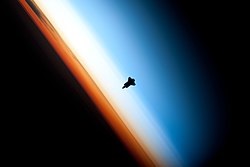|
|
| |
|
|
| |
|
|
|
|
| |
 |
| Space Shuttle
Endeavour to straddle the stratosphere and
mesosphere in this photo. The troposphere, which
contains clouds, appears orange in this photo. |
Mesosphere
The mesosphere (/ˈmɛsoʊsfɪər/; from Greek mesos,
"middle") is the third layer of the atmosphere, directly
above the stratosphere and directly below the
thermosphere. In the mesosphere, temperature decreases
as altitude increases. This characteristic is used to
define its limits: it begins at the top of the
stratosphere (sometimes called the stratopause), and
ends at the mesopause, which is the coldest part of
Earth's atmosphere with temperatures below −143 °C (−225
°F; 130 K). The exact upper and lower boundaries of the
mesosphere vary with latitude and with season (higher in
winter and at the tropics, lower in summer and at the
poles), but the lower boundary is usually located at
altitudes from 50 to 65 km (31 to 40 mi; 164,000 to
213,000 ft) above the Earth's surface and the upper
boundary (the mesopause) is usually around 85 to 100 km
(53 to 62 mi; 279,000 to 328,000 ft).
The stratosphere and the mesosphere are sometimes
collectively referred to as the "middle atmosphere",
which spans altitudes approximately between 12 and 80 km
above Earth's surface. The mesopause, at an altitude of
80–90 km (50–56 mi), separates the mesosphere from the
thermosphere—the second-outermost layer of Earth's
atmosphere. This is the turbopause, below which
different chemical species are well-mixed due to
turbulent eddies. Above this level the atmosphere
becomes non-uniform because the scale heights of
different chemical species differ according to their
molecular masses.
The term near space is also sometimes used to refer to
altitudes within the mesosphere. This term does not have
a technical definition, but typically refers to the
region of the atmosphere up to 100 km (62 mi; 330,000
ft), roughly between the Armstrong limit (above which
humans require a pressure suit in order to survive) and
the Kármán line (where astrodynamics must take over from
aerodynamics in order to achieve flight); or, by another
definition, to the range of altitudes above which
commercial airliners fly but below which satellites
orbit the Earth. Some sources distinguish between the
terms "near space" and "upper atmosphere", so that only
the layers closest to the Kármán line are described as
"near space". |
|
Temperature
Within the mesosphere, temperature decreases with
increasing height, due to decreasing absorption of solar
radiation by the rarefied atmosphere and increasing
cooling by CO2 radiative emission. The top of the
mesosphere, called the mesopause, is the coldest part of
Earth's atmosphere. Temperatures in the upper mesosphere
fall as low as −101 °C (172 K; −150 °F), varying
according to latitude and season.
Dynamic features
The main most important features in this region are
strong zonal (East-West) winds, atmospheric tides,
internal atmospheric gravity waves (commonly called
"gravity waves"), and planetary waves. Most of these
tides and waves start in the troposphere and lower
stratosphere, and propagate to the mesosphere. In the
mesosphere, gravity-wave amplitudes can become so large
that the waves become unstable and dissipate. This
dissipation deposits momentum into the mesosphere and
largely drives global circulation. This helps the Earth. |
|
Exploration
The mesosphere lies above altitude records for aircraft,
while only the lowest few kilometers are accessible to
balloons, for which the altitude record is 53.0 km.
Meanwhile, the mesosphere is below the minimum altitude
for orbital spacecraft due to high atmospheric drag. It
has only been accessed through the use of sounding
rockets, which are only capable of taking mesospheric
measurements for a few minutes per mission. As a result,
it is the least-understood part of the atmosphere,
resulting in the humorous moniker ignorosphere. The
presence of red sprites and blue jets (electrical
discharges or lightning within the lower mesosphere),
noctilucent clouds, and density shears within this
poorly understood layer are of current scientific
interest.
On February 3, 2003, Space Shuttle Columbia broke up on
reentry at about 62 km (39 mi) altitude, in the lower
mesosphere, killing all seven crew members. |
|
|
|
|
|
|
|
|
|
|
|
|
|
|
|
|
|
|
Search Fun Easy English |
|
|
|
|
|
|
|
|
|
|
|
|
|
|
|
About
Contact
Copyright
Resources
Site Map |